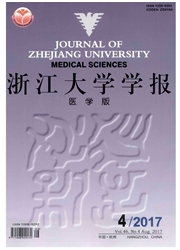

 中文摘要:
中文摘要:
目的:构建ZCH-7-2F9(简称2F9)单链抗体(ScFv2F9)原核表达载体,获得活性目的蛋白,为2F9免疫毒素及其它类型的基因工程抗体的研究奠定基础。方法:根据VH2F9、VL2F9、(G4S)3基因序列以及pIVEX2.3-MCS空载体多克隆位点内切酶位点NdeI和SinaI的核酸序列设计引物,采用高保真的Taq酶,通过重叠延伸拚接法(splicing by overlap extension,SOE)扩增克隆到ScFv2F9基因,T-A克隆、测序核实后克隆到pIVEX2.3-MCS空载体中,阳性重组质粒转化大肠杆菌菌株E.coli BL21star(DE3)plysS,IPTG诱导目的蛋白表达,镍树脂纯化后体外复性浓缩,流式细胞术观察其识别和结合CD14的能力。结果:成功构建ScFv2F9的原核表达载体pIVEX2.3-MCS/ScFv2F9;对大肠杆菌的包涵体进行纯化复性,其复性率为32.6%;通过流式细胞术观察到复性ScFv2F9对亲本单抗2F9-FITC有部分的阻滞效果,复性ScFv2F9阻滞1次后阳性细胞百分数、平均荧光强度(MFI)和高峰频道(peakCh)分别下降了11.73%、11.96%和31.57%,阻滞2次后分别下降了26.44%、21.75%和42.11%。结论:ScFv2F9在原核细胞中获得成功表达,复性后目的蛋白对人CD14有一定的识别和结合能力,为2F9单抗的进一步改造打下了坚实的基础。
 英文摘要:
英文摘要:
Objective: To construct a prokaryotic vector of ZCH-7-2F9 single chain antibody (ScFv2Fg) and to obtain the ScFv2F9 protein with biological activity for further studies. Methods:Primers were synthesized according to the gene sequence of ScFv2F9,four tandem glycin and one serine (G4S)3linker and multiple cloning site(MCS) of pIVEX2.3-MCS vector,which included NdeI and SmaI enzyme cleaving sites. NcFv2F9 gene was amplified through splicing by overlap extension (SOE) using the high fidelity Taq polymerase. Then the gene was cloned to pGEM-T easy and pIVEX2. 3-MCS vectors. Positive recombinants (plVEX2. 3-MCS/ScFv2F9 ) were identified through enzyme cleaving and sequenced before expression. The recombinant plasmids were transfected into E. coli BL21star(DE3)plysS for expression. After purification with Ni^+resin and renaturation in vitro, the relative molecular mass (Mr) and the binding activity of the interesting protein were determined by SDS-PAGE and flow cytometry (FCM), respectively. Results: The cloned ScFv2F9 gene was identified to be functional by sequencing and expressing. The interesting protein was detected in inclusion body with a Mr of 31 000. The blocking test showed that the positive cell percentage,the mean fluorescence intensity (MFI) and the peak of channel (peak Ch) were reduced by 11.73%, 11.96% and 31.57%,respectively after once blockage by seFv2F9 protein, and 26.44%, 21.75% and 42.11% after blockage twice. Conclusions: The NcFV2F9 against human CD14 antigen has been successfully expressed in prokaryotic cells with partial biological activity,which lays the foundation for further studies on its immunotoxin and other kinds of engineered antibodies.
 同期刊论文项目
同期刊论文项目
 同项目期刊论文
同项目期刊论文
 期刊信息
期刊信息
